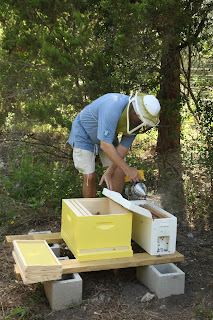 |
| Out in the yard with the hive box, the nuc, my smoker |
 |
| Smoking the nuc before opening the box |
 |
| The nuc is open and ready to move into the hive box. |
 |
| A little more smoke to calm the bees. |
 |
| I have pulled the first frame of the nuc and am ready to move it into the hive box. |
 |
| My first look at a frame of bees! |
 |
| One more look before loading the bees into the hive box. |
 |
| Three frames are in the hive box, and I am getting ready to load the final frame. |
 |
| Bees! This is what a nuc frame looks like! |
 |
| Our queen is in this little plastic box! |
The point of the queen cage is to keep the new queen in close proximity to the rest of the colony so her pheromones can take over the colony's bees. That takes 3-4 days...but you have to keep her alive during that time, so you have to protect her from the rest of the colony. The queen cage does just that: it has lots of air flow through it so her pheromones can get out, but the holes are too small for the bees to get in there and kill the queen. There is also a built-in time-release escape hatch, in the form of a candy plug. The queen eats the candy from the inside, the worker bees eat from the outside, and when they meet in the middle (4-5 days later), the queen is loose. By that time, her pheromones rule the hive, and the workers will all accept her as the new queen.
That's it for this post. Next up: our first hive inspection!










